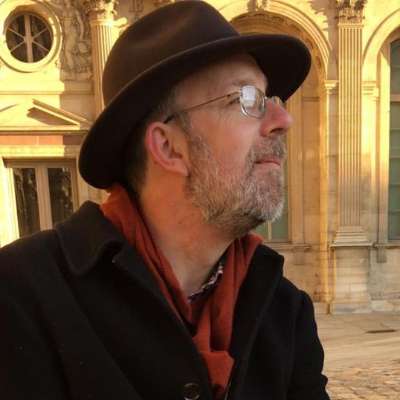“Listening to the Fifth Symphony of Ralph Vaughan Williams is like staring at a cow for 45 minutes.” Aaron Copland’s quip sums up the perceived wisdom about this composer: English, parochial, conservative. The popularity of works such as The Lark Ascending paint Vaughan Williams as a pastoralist, when there’s much more to him than that. He was, if anything, a city chap and considered himself a Londoner through and through, although he loved to travel to the countryside on field expeditions with fellow composer Gustav Holst to collect folk songs. RVW’s Pastoral Symphony is no “awakening of cheerful feelings on arrival in the countryside” pace Beethoven, but a meditation of his experiences in the First World War when he served as an ambulance driver.
As a composer, he had an international outlook, studying in Berlin with Max Bruch and in Paris with Maurice Ravel, yet he’s still seen as quintessentially English, with limited appeal beyond these shores. It’s refreshing, then, to see that (at the time of writing) nearly half of our concert listings containing his music take place outside the UK.
1Symphony no. 5 in D major
As a riposte to Copland’s snide critique, I’ve placed the Fifth Symphony at the head of my playlist. It’s Vaughan Williams’ most popular symphony for a reason, tapping into something deeply poignant, particularly in the Romanza third movement. Considering RVW was an agnostic, it’s a tremendously spiritual work, drawing heavily on music he had drafted for his yet-to-be-composed stage work, The Pilgrim’s Progress.
2Fantasia on a Theme of Thomas Tallis
The luminosity of RVW’s string writing in this work for strings never fails to move me. Based on a chant he discovered when editing the English Hymnal, RVW’s Tallis Fantasia is remarkable for the way he deploys different groups within his string orchestra – a main orchestra, a second “ghost” ensemble of nine players placed further away, and a string quartet. There’s a nobility and a gravitas to the music without it being sentimental.
3The Lark Ascending
Beloved and – bizarrely – despised for its popularity, The Lark Ascending is a beautiful tone painting for violin and orchestra. It was inspired by the poem by George Meredith that begins:
He rises and begins to round,
He drops the silver chain of sound,
Of many links without a break,
In chirrup, whistle, slur and shake.
It’s a quite remarkable piece of violin writing, based around three lengthy cadenzas in which there are no bar lines, offering the violinist complete metrical freedom.
4Symphony in F minor (no. 4)
Vaughan Williams’ Fourth Symphony opens with a crunching dissonance, taking us far from the world of larks and folksong. Written in the 1930s, it seems like a reflection of the anguished feelings occupying Europe ahead of the Second World War, but was his first symphony to be composed as pure music. RVW himself confessed, “I'm not at all sure that I like it myself now. All I know is that it's what I wanted to do at the time.” William Walton considered it the best symphony since Beethoven!
5Oboe Concerto
Vaughan Williams’ Oboe Concerto was composed around the same time as the Fifth Symphony; indeed, it began as sketches for a Scherzo intended for the symphony. It is unashamedly pastoral in nature, modestly scored for oboe and string orchestra. It was written for, and dedicated to, the great oboist Léon Goossens.
6Phantasy Quintet
Like the Tallis Fantasia composed two years earlier, the Phantasy Quintet (for string quartet plus extra viola) draws on music of the 16th and 17th centuries. The first viola plays a prominent role in the opening Prelude (it was RVW’s own instrument) and its burnished tone contributes greatly to the work’s warmth.
7A London Symphony
Vaughan Williams’ second symphony depicts scenes around his beloved London. Westminster chimes are unmistakable in the first movement, which then moves to Hampstead Heath on August bank holiday, while the second pictures Bloomsbury Square on a murky November afternoon. The Embankment and the Strand are evoked in the third movement, the finale a solemn march followed by a quiet epilogue inspired by a passage in HG Wells’ 1909 novel, Tono-Bungay, describing a nighttime voyage down the Thames:
“The last great movement in the London Symphony in which the true scheme of the old order is altogether dwarfed and swallowed up … The river passes – London passes, England passes.”
8On Wenlock Edge
AE Housman’s 1896 collection of poems A Shropshire Lad, with its themes of the military and dying too young, inspired a number of musical settings in the decades that followed. RVW’s On Wenlock Edge sets six of the poems including the haunting Is my team ploughing?, a conversation beyond the grave between a dead man and his still living best friend. Housman was irritated that Vaughan Williams omitted the third and fourth verses.
9Job: A Masque for Dancing
One of RVW’s least appreciated works, rarely performed, is the music to Job: A Masque for Dancing, written in 1931 for the Vic-Wells Ballet and choreographed by Ninette de Valois. The ballet is based on the Book of Job and is written in nine scenes, loosely based upon the sequence of William Blake's famous illustrations.
10Serenade to Music
This is one of the most sublime pieces by Vaughan Williams, based on a text from Shakespeare’s The Merchant of Venice. It features 16 vocal soloists – sometimes singing as a choir, sometimes solo lines – and was composed as a tribute to Sir Henry Wood, who conducted the premiere in 1938. Sergei Rachmaninov played his own Second Piano Concerto in the first half of the concert and, hearing the Serenade, is said to have wept at its beauty.




